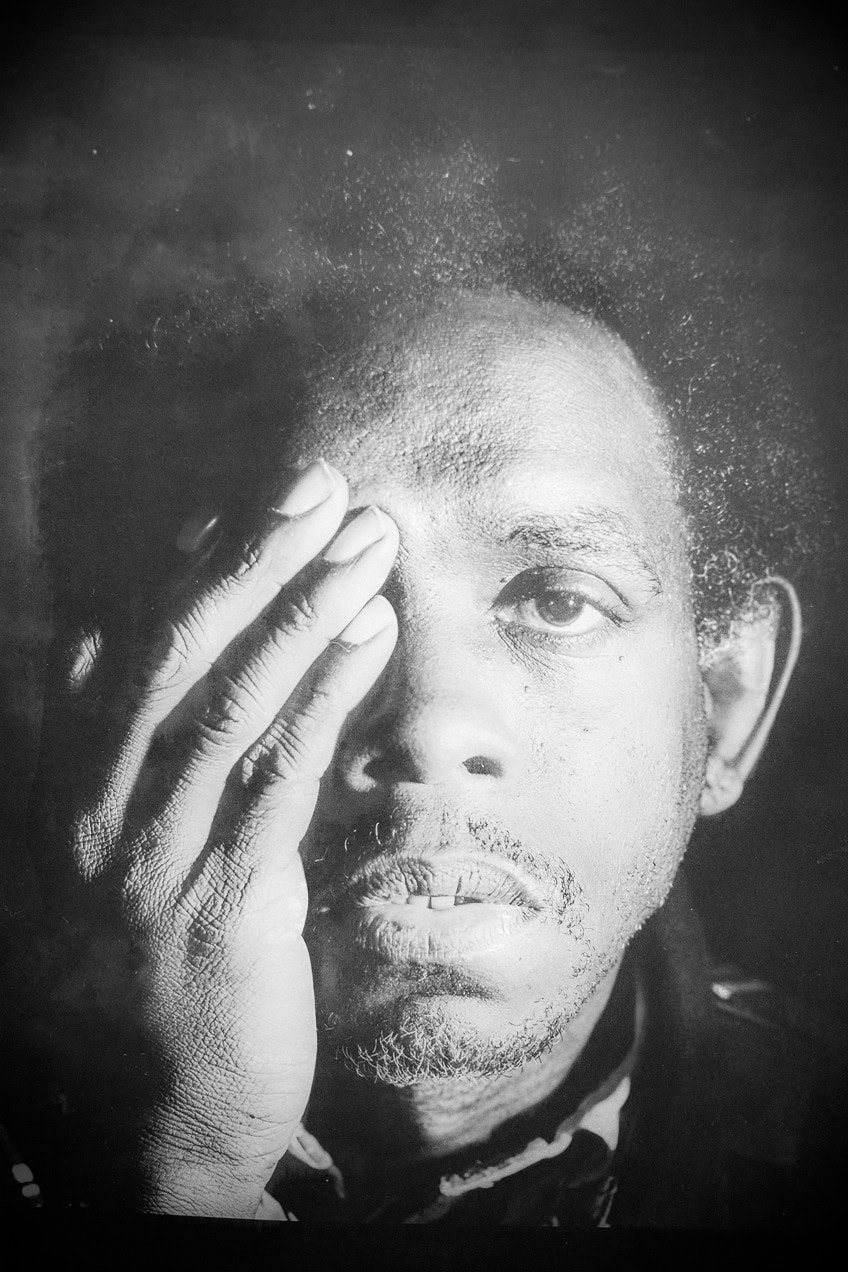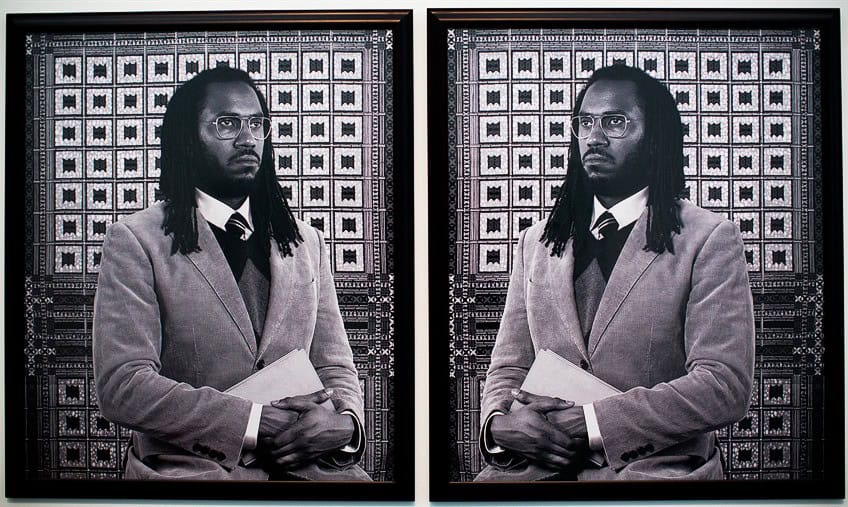Rashid Johnson – Blending Culture and Consciousness in Art
Rashid Johnson is a contemporary American artist renowned for his multifaceted approach to art, blending elements of painting, sculpture, photography, and installation. Born in 1977 in Chicago, Johnson has emerged as a pivotal figure in the post-black art movement, exploring themes of race, identity, and African-American history. His work often incorporates diverse materials such as shea butter, black soap, and vinyl records, reflecting his interest in African diasporic culture and personal memory. Johnson’s thought-provoking pieces challenge viewers to confront complex social issues while celebrating the resilience and creativity of Black culture.
Key Takeaways
- Rashid Johnson’s art explores themes of African American history and cultural identity.
- He gained prominence following his participation in the 2001 Freestyle exhibition.
- Johnson works with various media, including painting, sculpture, and installation.
Early Life and Education
| Birth | 1977 |
|---|---|
| Death | Present |
| Place of Birth | Chicago, Illinois, United States |
| Genre of Work | Conceptual art, sculpture, installation art, and painting |
Born in Chicago in 1977, Rashid Johnson has made a significant mark on the contemporary art scene. Johnson’s work is known for its conceptual depth, drawing from themes of African American history, cultural identity, and personal narrative. He first gained critical attention in 2001 during the Freestyle exhibition at the Studio Museum in Harlem, curated by Thelma Golden.
His education includes a BA in Photography from Columbia College Chicago and studies at the School of the Art Institute of Chicago.

Johnson employs a diverse range of media, including painting, sculpture, and installation art. His creations often reflect his own experiences and broader social issues. Johnson’s work has been globally exhibited, illustrating his influence and reach in the art world. With pieces that interrogate cultural and personal history, he continues to challenge and inspire both viewers and fellow artists.
Formative Years in Chicago
Rashid Johnson was born in 1977 in Evanston, Illinois, just beyond the city limits of Chicago. Growing up near Lake Michigan, he was exposed to the rich cultural environment of Chicago from an early age. His mother, a scholar of African history and a poet, played a pivotal role in shaping his early interests in history, literature, and art. This cultural inheritance motivated him to explore themes of racial and cultural identity later in his work.
As a child, he often visited the museums and cultural institutions of Chicago, which further instilled in him a deep appreciation for the arts. These experiences laid the groundwork for his future career as an artist.
Academic Pursuits in Art
Johnson’s formal education in art began at Columbia College Chicago, where he studied photography. It was during these years that he started to develop his distinctive style, characterized by the use of culturally significant materials and everyday objects. He later enrolled at the School of the Art Institute of Chicago, one of the most prestigious art schools in the United States. There, he expanded his artistic repertoire to include sculpture, painting, and other media.

His time at these institutions allowed him to engage with both contemporary and historical art practices. This period of academic training equipped him with the technical skills and conceptual frameworks that would define his later work in the field of Conceptual Post-Black art.
Artistic Evolution and Key Works
Rashid Johnson is a prominent contemporary artist renowned for his versatility and thematic focus on identity, race, and class. This section explores his artistic progression from photography to multidisciplinary works, investigates recurring themes in his art, and highlights some of his most notable exhibitions and installations.
Photography to Multidisciplinary
Johnson began his career with a strong focus on photography, capturing poignant moments and scenes that critiqued societal norms. As his work evolved, he embraced a multidisciplinary approach, incorporating sculpture, painting, drawing, video, and installation art.
This shift allowed him to experiment with various media and textures, such as surrender painting—a technique characterized by layers of materials and pigment.
His early works like Self-Portrait Pending illustrate this transition, blending photography with elements like branded wood. This evolution signifies a broader method of exploring themes that resonate deeply with contemporary art audiences.
Themes of Identity and Class
Central themes in Johnson’s work include identity, race, and class. He skillfully uses materials and objects to express these concepts, such as in Anxious Men, where black soap and wax serve as metaphors for the anxiety and complexity of black identity in America.

His pieces often reflect on personal and collective histories, challenging viewers to confront uncomfortable truths about societal structures. Johnson’s art not only serves as a personal narrative but also as a broader commentary on the black experience in a contemporary context.
Notable Exhibitions and Installations
Johnson’s work has been featured in numerous prestigious exhibitions across the globe. His participation in the 2001 Freestyle exhibition at the Studio Museum in Harlem marked his entry into the art world, gaining critical acclaim. Significant installations include The Broken Five at The Metropolitan Museum of Art and Untitled Anxious Drawing from 2017. These exhibitions showcase his ability to manipulate space and viewer perception, using large-scale installations to create immersive experiences.
His work continues to be celebrated for its innovative use of materials and powerful thematic undertones.
Conceptual Framework and Influences
Rashid Johnson’s work is deeply rooted in the exploration of cultural identity, often integrating diverse materials, symbolic references, and influences from literature and music. His practice engages with the traditions of both modern and post-black art.
Materials and Symbolism
Johnson frequently uses materials such as shea butter, black soap, ceramic tile, and wood in his installations. These materials often carry significant cultural and historical symbolism. For instance, shea butter and black soap are traditional African products, linking his work to African heritage and diasporic identities.

Ceramic tiles and wood are used to construct intricate, layered narratives that explore themes of identity, history, and memory. Incorporating these materials goes beyond their physical properties; they represent deeper connections to personal and collective histories, enhancing the conceptual depth of his work.
Literature and Music Inspirations
Literature and music play pivotal roles in Johnson’s art. He has cited influences such as James Baldwin, Ralph Ellison, and Sun Ra. Baldwin and Ellison, prominent African American writers, contribute to the exploration of Black identity in Johnson’s work. Sun Ra’s Afrofuturism inspires the futuristic and imaginative elements in his pieces. Music, especially jazz and hip-hop, underscores his creative process, often reflecting rhythm, improvisation, and cultural dialogue.
This fusion of literary and musical references adds layers of meaning and complexity to his installations, making them resonate on multiple levels.
Influence of Modern and Post-Black Art
Johnson’s work is informed by both modern art traditions and the concept of post-black art. He engages with the legacies of artists like Sam Gilliam, Mark Bradford, and Ed Clark, whose abstract and dynamic approaches resonate with his practice. Post-black art, a term that emerged in the 2000s, challenges fixed notions of Black art, allowing for a more fluid and expansive exploration of identity.
Johnson’s incorporation of diverse materials, symbolic references, and cultural narratives positions him within this contemporary framework, pushing the boundaries and redefining what Black art can be. His work embodies a dialogue between the past and the present, connecting historical influences with contemporary issues.
Rashid Johnson’s Impact and Legacy
Rashid Johnson has profoundly influenced contemporary art, creating works that explore and challenge Black cultural identity. His contributions and recognition within the art world are highlighted by his notable exhibitions and numerous accolades.
Contributions to Contemporary Art
Rashid Johnson is best known for his work in conceptual post-black art. He first gained critical attention in the Freestyle exhibition curated by Thelma Golden at the Studio Museum in Harlem in 2001. He employs diverse mediums such as painting, sculpture, photography, and installation. Key aspects of his work include:
- Exploration of Black identity and history
- Use of everyday materials to create complex narratives
- Integration of personal experiences and broader cultural themes
His works have been exhibited at prestigious institutions, including the Museum of Modern Art, The Met, Guggenheim Museum, and Whitney Museum of American Art. Each institution showcased his innovative approach to addressing themes of race and society.
Recognition and Awards
Rashid Johnson’s contributions to art have earned him significant accolades. By the age of 24, he was already recognized as a vital voice in contemporary art. His exhibitions, such as Message to Our Folks at the High Museum of Art, and works like the Bruise Paintings, have cemented his status as a leading artist. Notable recognitions include:
- Solo exhibitions at major museums
- Critical acclaim from art critics and scholars
- Honors from respected art institutions
Through these recognitions, Johnson’s work continues to inspire and influence both peers and emerging artists, securing his legacy within the art world.

Rashid Johnson’s dynamic and thought-provoking work continues to shape contemporary art, offering profound insights into the complexities of race, identity, and cultural memory. Through his innovative use of materials and interdisciplinary techniques, Johnson challenges conventional narratives and invites viewers to engage deeply with the African-American experience. As his influence expands globally, Johnson remains a vital voice in the art world, pushing boundaries and inspiring new generations to explore the intersections of art, history, and personal identity.
Frequently Asked Questions
What Mediums Does Rashid Johnson Primarily Work With in His Art?
Rashid Johnson frequently uses materials such as spray paint, oil sticks, ceramic, and mirrored tiles. These diverse mediums allow him to push the boundaries of traditional painting and explore new artistic territories.
How Has Rashid Johnson’s Cultural Background Influenced His Artwork?
Johnson’s work often includes autobiographical elements and references to African American culture. Pieces like Falling Man incorporate personal items and photographs, reflecting his own experiences and heritage.
What Notable Exhibitions Has Rashid Johnson Been a Part Of?
Johnson’s art has been showcased in significant venues such as the Smithsonian’s National Museum of African American History and Culture. His monumental works, like Antoine’s Organ, have received critical acclaim and highlight themes central to his oeuvre.
How Do Rashid Johnson’s Sculptures Explore Themes of Identity and History?
Johnson’s sculptures frequently address themes of identity and historical context through the use of recurring objects and motifs. The examination of race, longing, and escape is evident in his work, which often serves as a reflection on both personal and collective experiences.
Isabella studied at the University of Cape Town in South Africa and graduated with a Bachelor of Arts majoring in English Literature & Language and Psychology. Throughout her undergraduate years, she took Art History as an additional subject and absolutely loved it. Building on from her art history knowledge that began in high school, art has always been a particular area of fascination for her. From learning about artworks previously unknown to her, or sharpening her existing understanding of specific works, the ability to continue learning within this interesting sphere excites her greatly.
Her focal points of interest in art history encompass profiling specific artists and art movements, as it is these areas where she is able to really dig deep into the rich narrative of the art world. Additionally, she particularly enjoys exploring the different artistic styles of the 20th century, as well as the important impact that female artists have had on the development of art history.
Learn more about Isabella Meyer and the Art in Context Team.
Cite this Article
Isabella, Meyer, “Rashid Johnson – Blending Culture and Consciousness in Art.” Art in Context. September 16, 2024. URL: https://artincontext.org/rashid-johnson/
Meyer, I. (2024, 16 September). Rashid Johnson – Blending Culture and Consciousness in Art. Art in Context. https://artincontext.org/rashid-johnson/
Meyer, Isabella. “Rashid Johnson – Blending Culture and Consciousness in Art.” Art in Context, September 16, 2024. https://artincontext.org/rashid-johnson/.











